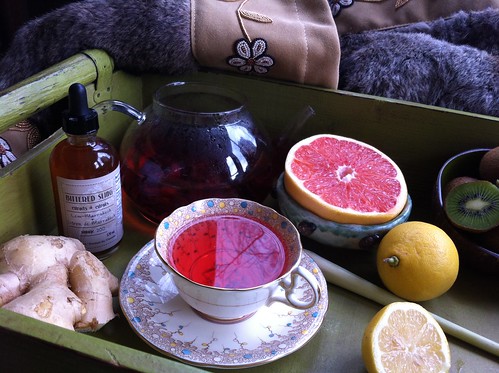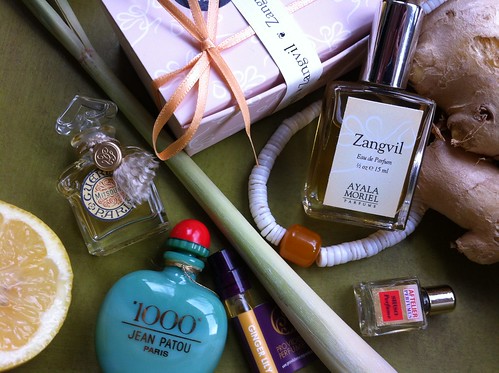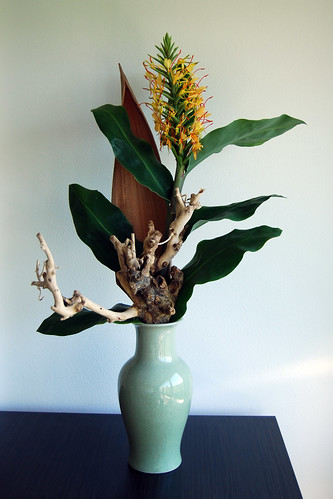The Modern Sage: A Case Study
Sampling Wood Sage & Sea Salt this weekend instantly reminded me of Fig Leaf & Sage. The new limited edition offering from Jo Malone inspired me to bring up the topic of sage: an herb that is near and dear to my heart. Growing up with it, it has been used in my household to treat any ailment you can imagine - from sore throat and upset stomach to mouthwashing and hair-rinsing. Therefore, I never cared for it so much as an herbal tea - it has too strong of a medicinal association for me in that format.
Another story altogether is safe as fresh or dried leaves in the wild, as well as its uses in cookery (sage leaves in butter, anyone?), or even baked goods (sage & blackberry thumbprint cookies are now a family tradition). I remember the first time when I had sage inside a pasta sauce. It was at a wedding of one of my mom's cousins, who owned a catering company at the time. Her brother asked me what I thought about it, and I was kinda cynical... It's just like the herbs on our mountains", I said. "We drink it all the time". I did not enjoy it at the time, but years later, sage has become a staple herb in my kitchen, both dried and fresh, to give more depth to simple roasted vegetables (butternut squash, potatoes) or pasta sauces. It just takes those dishes to the next level... Personally, I find the whole leaf is a little more complex and intriguing, and somehow bypasses the medicinal association.
Ditto for its use in perfumery. It is one of my favourite accessory notes, actually. Thank God my mom's herbal medicine practices didn't ruin it for me completely... Sage is an integral part of some of the perfumes I'm most proud of, especially from the Chypre family: Ayalitta, Autumn. I also fell in love quite late with Clary Sage (but that's another story). When done correctly and artfully, what sage does to a perfume is something that's inexplicable. It normally does not really smell like sage at all - but rather creates a full-bodied smudging effect, akin to smearing your fingers forcefully over a thick line of pastel crayons. It has a bold presence, but it does not really come across as an attention seeker. Rather, brings out the brave voices of otherwise demure notes such as jasmine, rose or amber.
Now, there are several types of sage, but the one discussed here is the common sage, Salvia officinalis. It grows wild in the Mediterranean region, and has a very warm, earthy, herbaceous scent. According to Julia Lawless' Encyclopedia of Essential Oils, the principal constituents are thujone (about 42%), cineol, borneol, caryophyllene and other terpenes. Borneol is an alcohol that gives it a camphoreous character, and cineol is another alcohol, characteristics of eucalyptus and rosemary - camphoreous but also a little warm or even spicy if you will.
Thujone, on the other hand, is a ketone and a monoterpene, and its scent is well known as white cedar, yellow cedar or arborvitae (Thuja occidentalis), and is native to the northeastern parts of Canada and the USA. It is not a true cedar, but actually belongs to the cypress family (Cupressaceae). in wormwood (especially in Artemisia absinthium), and also in juniper, mugwort, tansy and oregano. Thujone is controversial in aromatherapy and liquor preparations: It is a GABA receptor inhibitor (or antagonist). It can cause side effects such as anxiety and insomnia. In high doses, it's toxic to the brain, liver and kidney, and can causes convulsion, and can even be lethal. The are liquor regulations in Europe and North America that control the level of thujone in liquors such as Absinthe. However, when used cautiously and in moderation (for example: as an herbal tea, or in very low dilutions within an essential oil such as common sage), it can help strengthen the immune system, and help in situations such as colds and viral infections.
Now, the reason I discussed thujone so much here, is because in the three modern sage-centred fragrances I am testing today, what I'm really smelling is thujone, not so much sage. Thujone has simultaneously a fruity but also a strong and quite sickening woody-coniferous smell on its own. And indeed, sage has that effect of creating an illusion of fruitiness in a perfume, as you shall see.
Fig Leaf & Sage by Kiehl's is an original yet approachable, marketed as a non-committal cross between a scented ancillary product (body spray) and perfume. Fig Leaf & Sage is simultaneously fruity yet not exactly sweet, with an herbaceous-dry sage notes and a certain tart, almost green undertones reminiscent of green figs (perhaps not quite ripe yet). It's certainly a duet, at least for the first hour or so of wearing - tilting between green figs and sage like an airplane that hasn't decided yet where to land. I find this to be quite an unusual fragrance; but I also find the drydown to be way too musky and synthetically ambery scent to my taste. Nevertheless, I keep coming back to it, so I won't be surprised if a small sized bottle will end up joining my ever growing collection of fragrant marvels...
Wood Sage & Sea Salt Cologne by Jo Malone smelled at first just like how I remembered Fig Leaf & Sage. Must be the thujone. It really comes across strongly at first. As expected from this brand, it's a lot more tame, and also a lot more transparent. And also about 5 times the price. It last only a couple of hours on the skin (and not much longer on the scent strip). At first, there is a burst of musky, fruity sage-ness; but paired with very light citrus notes. And marine notes. And also a reminiscence of their Black Pomegranate - kinda fruity, dark yet transparent woody-leathery note that is I suspect the modern answer to isobutyl quinoline, and a rather insipid answer I'm afraid - lacking the depth and intrigue of the former, and leaving you high and dry with a flat, sterile smoky-wood finish. While sweet at first, it dries down rapidly, if I may emphasize my point. And there is a coconutty, yet also fake marine-like quality in there that is not appealing at all to me (though much more pleasant and creamier in the matching body cream).
Lemongrass Sage Hand & Nail Cream is not a perfume per se, but it's the scent of this product that I like, and the first one of this type of "sage" scent that I came across (while killing time for a connection at SEATAC airport). Again, the thujone is more dominant than it is in actual sage oil. And it's slightly fruit-like ketone quality added a lot to the lemongrass - an oil that often smells dull, as it is too commonly distilled from the dried leaves instead of the fresh ones (and sometimes not the freshest quality either).






